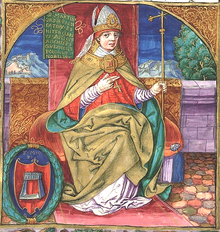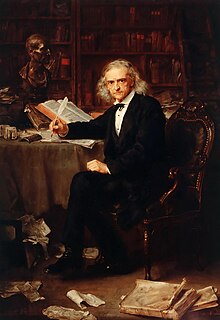Liber Pontificalis
The work of the French priest Louis Duchesne (who compiled the major scholarly edition), and of others has highlighted some of the underlying redactional motivations of different sections, though such interests are so disparate and varied as to render improbable one populariser's claim that it is an "unofficial instrument of pontifical propaganda.[4] As enlarged in the 6th century, each biography consists of: the birth name of the pope and that of his father, place of birth, profession before elevation, length of pontificate, historical notes of varying thoroughness, major theological pronouncements and decrees, administrative milestones (including building campaigns, especially of Roman churches), ordinations, date of death, place of burial, and the duration of the ensuing sede vacante.[2] Early in the 14th century, an unknown author built upon the continuation of Petrus Guillermi, adding the biographies of popes Martin IV (d. 1285) through John XXII (1316–1334), with information taken from the "Chronicon Pontificum" of Bernardus Guidonis, stopping abruptly in 1328.[2] The Liber Pontificalis was first edited by Joannes Busaeus under the title Anastasii bibliothecarii Vitæ seu Gesta Romanorum Pontificum (Mainz, 1602).[2] Muratori reprinted Bianchini's edition, adding the remaining popes through John XXII (Scriptores rerum Italicarum, III).Texte, introduction et commentaire, 2 vols., Paris, 1886–92) and Theodor Mommsen (Gestorum Pontificum Romanorum pars I: Liber Pontificalis, Mon.



Martin of OpavaJeromeDamasus ISt. PeterbiographiesSaint PeterPope Adrian IIPope Stephen VPope Eugene IVPope Pius IILouis DuchesneRabanus MaurusSaint JeromePope Damasus IapocryphalHegesippusIrenaeusEusebius of CaesareaOnofrio PanvinioPope Nicholas IAnastasius BibliothecariusCaesar BaroniusCiampiniSchelstratePope Stephen IIPope Felix IIIPope Anastasius IICatalogus LiberianusHippolytus of Romepapal treasuryEdward GibbonDecline and Fall of the Roman EmpirePope SilveriusPope Cononchurchesordinationssede vacantePope John VIIIPope Marinus IPope Adrian IIImonastery of St. GillesDiocese of ReimsPope Leo IXPope Honorius IIPope Paschal IIPope Urban IIPope Gregory VIIPandulfGiesebrechtPope Martin IVMartin IVJohn XXIIChronicon PontificumBernardus Guidoniscardinal-nephewPope Adrian IVCardinal BosoLiber CensuumPope Honorius IIIBonizo of SutriJohn XIIGregory VIIGelasius IIAlexander IIIPope Urban VPope Martin VWestern SchismBenedict XIIMartin VEugene IVPope Urban VITheodor Mommsenfirst editedJoannes BusaeusHistoria ecclesiasticaPope Stephen VIFr. BianchiniMon. Germ. hist.Annales RomaniList of popesCatholic EncyclopediaGibbon, EdwardPope Felix IVAdrian IPope Gregory I